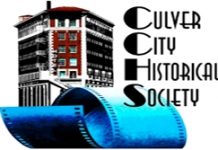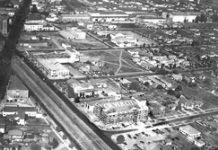“City packed with visitors for opening of Culver skyscraper” was the September 4, 1924 headline in the Culver City Daily News. The six story Hotel Hunt, (now the Culver Hotel), was called the “latest monument to his vision,” his referring to our visionary city founder, Harry Culver.
Culver chose Los Angeles firm Curlett and Beelman to design the hotel. They specialized in large commercial structures like the Park Plaza Hotel, the Hollywood Roosevelt Hotel and the Union Oil buildings on West 7th in downtown Los Angeles. Beelman went on to design the Eastern Columbia Building, and the Thalberg Administration Building at Metro-Goldwyn Mayer (1938), now Sony Pictures Studios.
The wedge-shaped Renaissance Revival style Culver Hotel is concrete and brick with mahogany and walnut interiors. It was built on property in the center of downtown, on what has been called “the shortest Main St. in the USA.”
Culver City’s first movie theatre was located on this site, with its second floor utilized as the first city offices. The city moved their offices nearby to Van Buren Place, and a new movie theatre, the Meralta, was built on the site of today’s Meralta Plaza (mid-block), to make way for this new landmark hotel. It was the tallest structure between the ‘pueblo’ of Los Angeles and Abbot Kinney’s resort of Venice.
Over the years, the hotel has become recognizable from movies filmed here, including Laurel and Hardy shorts like “Putting Pants on Philip,”(1927). Numerous stars, like Red Skelton, Clark Gable, Joan Crawford, Greta Garbo, and Ronald Reagan, maintained part-time residences there.
In an interview in 1989, at a Culver City Historical Society event at The Culver Studios, actor Jerry Maren, recalled this hotel as the home of the “Munchkins” when “The Wizard of Oz” began filming in 1938. Maren, who played the “Lollipop Kid,” quipped that size allowed three to fit sideways in a bed. He remembered arriving around midnight, only to awaken in the morning to a band playing. He and the rest of the “little people” thought they were being honored, until they looked out their windows to see the Armistice Day Parade passing by!
John Wayne, who is listed as owner of the Culver City Hotel in 1939, donated it to the Los Angeles YMCA. Red Skelton is rumored to have owned it as well. Lou Catlett, of Historic Hollywood Properties, rescued the hotel from real estate speculators who allowed it to deteriorate. The amazing restoration, including the reconfiguration of rooms to allow for baths in each room—not at the end of the hall, and seismic retrofitting, was accomplished in partnership with the CC Redevelopment in the 1990s.
It was not until the current owners took over, however, and engaged local home-grown, Doug Newton, that The Culver Hotel returned to glory. The hotel is protected with “Landmark” status by the City of Culver City, under the city’s historic preservation ordinance and it is listed on the National Register of Historic Places.
This month, our nation celebrates Historic Preservation Month. A visit to the Culver Hotel just reinforces the importance of historic preservation, its economic benefits to the owner and the city and manager Seth Horowitz can proudly talk about four stars, too.













